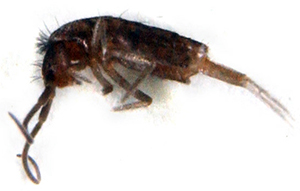Springtails in nurseries
Extra moisture this summer may cause springtails to be abundant in nursery beds. The majority of springtails are beneficial eating bacteria, fungi, algae and decaying vegetation.

Nursery growers or staff may be seeing small black, jumping insects when weeding their seedbeds this summer. These very small bugs are called springtails and are members of the order Collembola. Approximately 700 different species of springtails live in North America. Springtails are minute, primitive insects about 1/32” long and may be black, gray, white, brown or yellow in color. They can be distinguished by their peculiar habit of jumping into the air. If you catch one and look at it with a hand lens, they have a forked appendage (furculum) on the rear of their abdomen. Normally a springtail holds the furculum under its body, but when disturbed will extend it quickly, causing them to jump an inch or more.
When conditions or the habitat is right, springtails can occur in enormous numbers (50,000 per cubic foot). Springtails can be found outdoors in any moist situation, usually feeding on algae, fungi and decaying vegetation. There are a few species that can feed on plants but we haven’t found damage from springtails in nurseries. In most cases, springtails are beneficial by speeding up the process of decay and returning nutrients back into the soil. However, if you are finding large numbers you may want to monitor young seedlings.
Although it may be tempting to spray a large springtail problem with an insecticide, the products available are generally not very effective against them even with multiple applications. Controlling moisture levels can be an effective strategy as they are extremely sensitive to moisture. If their normal environment becomes dry, they will move to actively seek moisture.

Close-up adult springtail. Photo by Phil Myers, Museum of Zoology, University of Michigan-Ann Arbor



 Print
Print Email
Email


